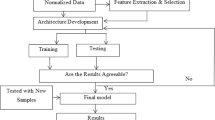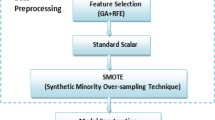Abstract
Job stress is an important phenomenon, which affects many people around the world and impacts the performance and success of companies. It has an economic impact amounting to billions of dollars each year. Stress is related to the perception of people about their abilities to fulfill their functions. New information and communications technologies provide a way to monitor activities and behavior continually. We have developed a model to recognize job stress in its initial stages or before it becomes visible; which is useful for both employees and employers. Our proposal is based on the behavior and physical activities of employees detected through a Fitbit® wrist-worn sensor. The model was built considering the recognized behavior patterns in a group of employees and their own perception of job stress. We conducted a study to gather data to build the model. Our proposal relies on machine learning techniques. We evaluated several classifier algorithms such as: ZeroR, k-nearest-neighbor, Naive Bayes, random forest, J48, and AdaBoost. We found random forest obtained the best performance. We evaluated the model with a test dataset with encouraging results, obtaining good scores for accuracy, precision, recall, and F-measure metrics.









Similar content being viewed by others
References
Aha DW, Kibler D, Albert MK (1991) Instance-based learning algorithms. Mach Learn 6(1):37–66. https://doi.org/10.1007/BF00153759
Bakker J, Pechenizkiy M, Sidorova N (2011) What’s your current stress level? Detection of stress patterns from GSR sensor data. In: 2011 IEEE 11th international conference on data mining workshops, no 1, pp 573–580. https://doi.org/10.1109/ICDMW.2011.178
Beehr TA (1995) Psychological stress in the workplace. Routledge and Taylor & Francis Group, New York
Blaug R, Kenyon A, Lekhi R (2007) Stress at work: a report prepared for the work foundation’s principal partners. http://www.theworkfoundation.com. Accessed 30 Nov 2018
Borradaile GJ (2003) Statistics of earth science data: their distribution in time, space and orientation. Springer, Berlin
Breiman L (2001) Random forests. Mach Learn 45(1):5–32. https://doi.org/10.1023/A:1010933404324
Carneiro D, Castillo JCJC, Novais P, Fernández-Caballero A, Neves JJ (2012) Multimodal behavioral analysis for non-invasive stress detection. Expert Syst Appl 39(18):13376–13389. https://doi.org/10.1016/j.eswa.2012.05.065
Carneiro D, Pimenta A, Gonçalves S, Neves J, Novais P (2016) Monitoring and improving performance in human-computer interaction. Concurr Comput Pract Exp 28(4):1291–1309. https://doi.org/10.1002/cpe.3635
Carneiro D, Novais P, Augusto JC, Payne N (2017) New methods for stress assessment and monitoring at the workplace. IEEE Trans Affect Comput 14(8):1–1. https://doi.org/10.1109/TAFFC.2017.2699633
Chawla NV, Bowyer KW, Hall LO, Kegelmeyer WP (2002) SMOTE: synthetic minority over-sampling technique. J Artif Intell Res 16:321–357
Cvetkovic B, Gjoreski M, Sorn J, Freser M, Bogdanski M, Jackowska K, Lustrek M et al (2017) Management of physical, mental and environmental stress at the workplace. In: 2017 international conference on intelligent environments (IE). IEEE, pp 76–83. https://doi.org/10.1109/IE.2017.20
Day S (2016) Self-tracking over time: the FITBIT® phenomenon. In: ITx 2016, incorporating the 7th annual conference of Computing and Information Technology Research and Education New Zealand (CITRENZ2016) and the 29th annual conference of the national advisory committee on computing qualifications, pp 21–26
Dunteman GH (1989) Principal components analysis. In: Quantitative applications in the social sciences, vol 69. SAGE Publications, Newbury Park
European Agency for Safety and Health at Work (EU-OSHA) (2014) Calculating the cost of work-related stress and psychosocial risks. Publ Off Eur Union. https://doi.org/10.2802/20493
European Commission (2002) Guidance on work-related stress: spice of life or kiss of death. Luxembourg. https://www.stress.org/wp-content/uploads/2011/11/Guidance2520on2520workrealted2520stress.pdf. Accessed 30 Nov 2018
Freund Y, Schapire RE (1996) Experiments with a new boosting algorithm. In: 13th international conference on machine learning, pp 148–156
Garcia-Ceja E, Osmani V, Mayora O (2015) automatic stress detection in working environments from smartphones’ accelerometer data: a first step. Biomed Health Inform IEEE J. https://doi.org/10.1109/JBHI.2015.2446195
Gjoreski M, Janko V, Gjoreski H (2016) Activity and stress monitoring using smartphone and wrist device. In: 7th Jožef Stefan international postgraduate school students’ conference. Ljubljana, pp 154–164
Griffiths A (1998) The psychosocial work environment. In: McCaig R, Malcolm Harrington J (eds) The changing nature of occupational health. HSE Books, pp 213–232
Griffiths A, Cox T (1995) The nature and measurement of work stress: theory and practice. In: Wilson JR, Corlett N (eds) Evaluation of human work. London
Hall MA (1999) Correlation-based feature selection for machine learning. The University of Waikato. http://citeseerx.ist.psu.edu/viewdoc/summary?doi=10.1.1.37.4643. Accessed 30 Nov 2018
Hall M, Frank E, Holmes G, Pfahringer B, Reutemann P, Witten IH (2009) The WEKA data mining software: an update. SIGKDD Explor 11(1):10–18. https://doi.org/10.1145/1656274.1656278
Han J, Pei J, Kamber M (2011) Data mining: concepts and techniques. Elsevier, Waltham
Hernandez J, Morris RR, Picard RW (2011) Call center stress recognition with person-specific models. In: Affective computing and intelligent interaction, vol 6974, pp 125–134. https://doi.org/10.1007/978-3-642-24600-5_16
Hernandez J, Benavides X, Maes P, McDuff D, Amores J, Picard RW (2014a) AutoEmotive: bringing empathy to the driving experience to manage stress. In: Designing interactive systems, New York, pp 53–56. https://doi.org/10.1145/2598784.2602780
Hernandez J, Paredes P, Roseway A, Czerwinski M (2014b) Under pressure: sensing stress of computer users. In: ACM SIGCHI conference on human factors in computing systems, New York, pp 51–60. https://doi.org/10.1145/2556288.2557165
Hernández Y, Pérez-Ramírez M, Zatarain-Cabada R, Barrón-Estrada L, Alor-Hernández G (2016). Designing empathetic animated agents for a B-learning training environment within the electrical domain. J Educ Technol Soc. https://doi.org/10.2307/jeductechsoci.19.2.116
Hernandez-Leal P, Maxhuni A, Sucar LE, Osmani V, Morales EF, Mayora O (2015) Stress modelling using transfer learning in presence of scarce data. Ambient Intell Health 1–12
Huang MX, Li J, Ngai G, Leong HV (2016) StressClick: sensing stress from Gaze-Click patterns. In: Proceedings of the 2016 ACM on multimedia conference—MM’16, pp 1395–1404. https://doi.org/10.1145/2964284.2964318
John GH, Langley P (1995) Estimating continuous distributions in Bayesian classifiers. In: Proceedings of the eleventh conference on uncertainty in artificial intelligence. Morgan Kaufmann Publishers Inc, San Francisco, pp 338–345
Kohavi R, John GH (1997) Wrappers for feature subset selection. Artif Intell 97(1–2):273–324. https://doi.org/10.1016/S0004-3702(97)00043-X
Koldijk S, Neerincx MA, Kraaij W (2016) Detecting work stress in offices by combining unobtrusive sensors. IEEE Trans Affect Comput 3045(c):1–1. https://doi.org/10.1109/TAFFC.2016.2610975
Loyola O, Medina MA, García M (2015) Inducing decision trees based on a cluster quality index. IEEE Lat Am Trans 13(4):1141–1147
Majoe D, Bonhof P, Kaegi-trachsel T, Gutknecht J, Widmer L (2010) Stress and sleep quality estimation from a smart wearable sensor. In: Pervasive computing and applications (ICPCA), pp 14–19. https://doi.org/10.1109/ICPCA.2010.5704068
Murphy SA, Duxbury L, Higgins C (2006) The individual and organizational consequences of stress, anxiety, and depression in the workplace: a case study. Can J Community Ment Health 25(2):143–157. https://doi.org/10.7870/cjcmh-2006-0018
Plarre K, Raij A, Hossain SM, Ali AA, Nakajima M, Absi M, Wittmers LE et al (2011) Continuous inference of psychological stress from sensory measurements collected in the natural environment. In: Information processing in sensor networks (IPSN), pp 97–108
Quinlan R (1993) C4.5: Programs for machine learning. machine learning. Morgan Kaufmann Publishers, Burlington. https://doi.org/10.1007/BF00993309
Raij A, Blitz P, Ali AA, Fisk S, French B, Mitra S, Smailagic A et al (2010) mStress: supporting continuous collection of objective and subjective measures of psychosocial stress on mobile devices. Technical report No. CS-10-004
RStudio Team (2016) RStudio: integrated development for R. RStudio, Inc. Boston. http://www.rstudio.com/. Accessed 30 Nov 2018
Sano A, Picard RW (2013) Stress recognition using wearable sensors and mobile phones. In: Humaine association conference on affective computing and intelligent interaction. IEEE, pp 671–676. https://doi.org/10.1109/ACII.2013.117
Sharma A, Dey S (2012) Performance investigation of feature selection methods and sentiment lexicons for sentiment analysis. IJCA Special Issue Adv Comput Commun Technol HPC Appl 3:15–20
Sharma N, Gedeon T (2013) Modeling stress recognition in typical virtual environments. In: Proceedings of the ICTs for improving patients rehabilitation research techniques, pp 17–24. https://doi.org/10.4108/pervasivehealth.2013.252011
Sohail M (2015) Stress and health at the workplace—a review of the literature. J Bus Stud Q 6(3):94–121
Szmidt E, Kacprzyk J (2010) The Spearman rank correlation coefficient between intuitionistic fuzzy sets. In: 2010 5th IEEE international conference intelligent systems, pp 276–280. https://doi.org/10.1109/IS.2010.5548399
Ulinskas M, Wo M, Woźniak M, Damaševičius R (2017) Analysis of keystroke dynamics for fatigue recognition. Lect Notes Comput Sci 10409:235–247. https://doi.org/10.1007/978-3-319-62407-5
Univaso P, Ale JM, Gurlekian JA (2015) Data mining applied to forensic speaker identification. IEEE Lat Am Trans 13(4):1098–1111. https://doi.org/10.1109/TLA.2015.7106363
Witten IH, Frank E, Hall M (2011). Data mining: practical machine learning tools and techniques, 3rd edn. Morgan Kaufmann, Burlington. https://doi.org/10.1002/1521-3773(20010316)40:6%3C9823::AID-ANIE9823%3E3.3.CO;2-C
Author information
Authors and Affiliations
Corresponding author
Additional information
Publisher’s Note
Springer Nature remains neutral with regard to jurisdictional claims in published maps and institutional affiliations.
Rights and permissions
About this article
Cite this article
Sanchez, W., Martinez, A., Hernandez, Y. et al. A predictive model for stress recognition in desk jobs. J Ambient Intell Human Comput 14, 17–29 (2023). https://doi.org/10.1007/s12652-018-1149-9
Received:
Accepted:
Published:
Issue Date:
DOI: https://doi.org/10.1007/s12652-018-1149-9




